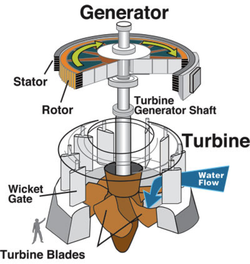What is Hydropower?
From the Greek turning waterwheels producing flour to the world’s first
hydroelectric plant in Appleton, Wisconsin during the year 1882, water has been
used as a source of energy for generations.
Hydroelectric power has impacted millions of people around the world. In the United States, today, there are
approximately 95,000 Megawatts of hydroelectric generating plants which is
equivalent to 500 million barrels of oil. Hydroelectricity has an
enormous impact on our country! The amount of power generated can supply power
to twenty-eight million households, or approximately twenty-seven percent of
the United States population. Millions of people have no idea
that just a little running water in a stream can change the world. According
the Foundation for Water and Energy Education (2006), hydroelectric power also
makes up approximately ten percent of US electricity and sixty-seven percent of
US renewable energy. The energy currently emits one of the lowest
amounts of greenhouse gas. However, the
United States is currently at its maximum for hydroelectric plants because
falling water generated by a dam is not appropriate everywhere. Therefore, small scale generators
work best.
How do hydroelectric generators work?
Hydroelectric generators work by converting the energy of water,
potential energy, into mechanical energy, in order to turn the water’s energy
into electricity. When flowing water moves through a generator, its force
propels the rotor, which is controlled by the turbine. The rotor travels past
the wire stator conductor, which causes electricity to flow. This basic
principle, known as Faraday’s Law,
was discovered by Michael Faraday in 1831.
Knowing this makes it possible to create any electrical generator or motor.

